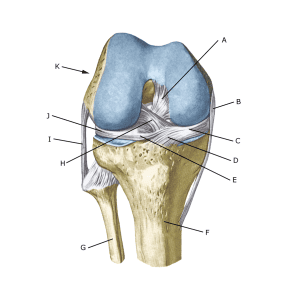Anatomy
The bones of the knee joint include the femur (thigh bone), tibia (shin bone) and patella (kneecap). There is also a small joint between the tibia and fibula (fibula). The knee joint is reinforced by a joint capsule that is laterally reinforced with an external and internal collateral ligament (ligamentum collaterale laterale, LCL and mediale, MCL). Inside the knee are two menisci: an external (lateral) and an internal (medial) meniscus that stabilise the knee joint. There are also two ligaments, the anterior and posterior cruciate ligaments (ligamentum cruciatum anterius, ACL and posterius, PCL).
Knee joint from the front:
 A. Ligamentum cruciatum posterius (Posterior cruciate ligament)
A. Ligamentum cruciatum posterius (Posterior cruciate ligament)
B. Ligamentum collaterale mediale/tibiale (Inner collateral ligament
C. Meniscus medialis (Inner meniscus)
D. Insertio anterior menisci medialis
E. Ligamentum transversum genus
F. Tibiae
G. Fibulae
H. Ligamentum cruciatum anterius (Anterior cruciate ligament)
I. Ligamentum collaterale laterale/fibulare (External collateral ligaments)
J. Meniscus lateralis (Outer meniscus)
K. Femur
Cause of the problem
ACL tears are usually caused by a punch or kick directly into the front of the tibia just below the knee. See foto
Symptoms
Usually a pop is heard or felt and further sports activity must be cancelled. The knee may swell within the first few hours, after which the knee cannot fully bend. Relatively often there is no swelling in the knee. Afterwards, you can often feel the leg giving way (knee failure).
Examination
If you suspect a total or partial rupture of the posterior cruciate ligament, you should see a doctor (emergency room) for a diagnosis. The doctor can perform various knee tests (posterior drawer laxity) to examine the stability of the knee.
It should be noted that looseness in the knee can often only be detected after 1-2 weeks. It is often necessary to supplement with MRI scans, ultrasound scans to make the diagnosis with certainty. See ultrasoundscan.
Treatment
The treatment of isolated posterior cruciate ligament tears usually primarily involves relief from pain-inducing activity and graduated rehabilitation within the pain threshold. Only in cases of pronounced looseness or if the tear is combined with other ligament tears can surgery be considered.
Bandage
The hinge bandage (Don-Joy) can be used for the first few weeks.
Complications
If no progress is made, an MRI scan should be performed.
In particular, the following should be considered:
Specifically
As there is a risk of permanent damage, the injury should be reported to your insurance company.
